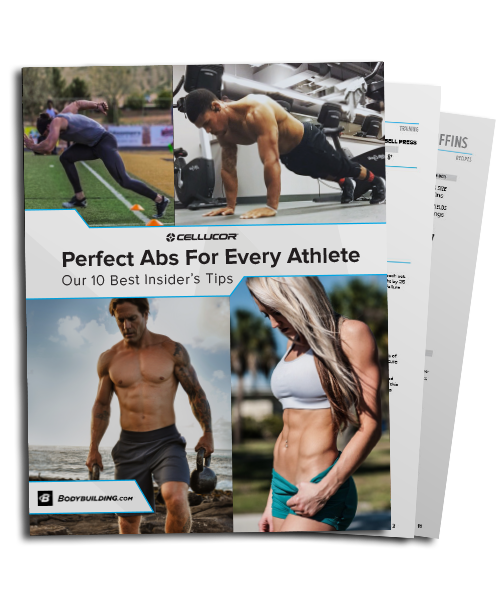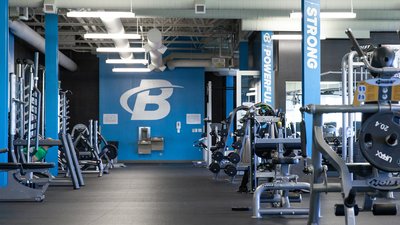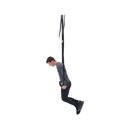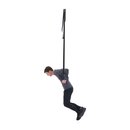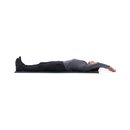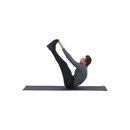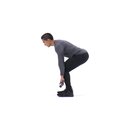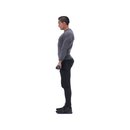Main Page | Ab Training Tips PDF | Offseason Abs | 5 Core Moves Instagram-Worthy Abs | Redefine Your Abs
Crossfitters, powerlifters, gymnasts, strongmen, Olympic lifters, NFL linemen, bodybuilders—different sports with very different physiques, but they share one attribute inside: a strong core.
Sure, some of those athletes can show off a rippling six-pack on demand while others are anything but ripped. But according to Eric Botsford, a CrossFit competitor, coach, and Cellucor athlete, focusing just on visuals is missing the forest for the trees. "Your 'abs' are just the tip of the iceberg when it comes to your true 'core,'" says Botsford. "Everyone wants the six-pack (rectus abdominis), but lying underneath, moving up, down, and even diagonally across the torso are layers of muscle fibers that contribute to your effectiveness as an athlete as well as a functioning human being."
So is the answer to augment your regular training with interminable high-rep core-focused workouts? Nope, says Botsford. Instead, you can seamlessly add a few moves to your existing workouts to dramatically increase the strength and functionality of your core.
These moves can make the difference between strolling out of the box confidently with your best WOD time or heading straight to the chiro. So listen up!
1. Build Isometric Strength With Static Holds
"As I say to the members in the gym, 'Every day is core day,' and it couldn't be more true," says Botsford. "We practice a variety of lifts, presses, pushes, and agility movements that always begin with bracing. As with many activities in life, you must brace through your midsection to support these movements, holding your core stable before beginning the movement."

Ring-support hold
But what if, like many people, you're just not very good at bracing? Then you need to practice it with moves that both demand and develop isometric strength.
"One way I build static strength is to practice gymnastic-ring support holds," Botsford says. Using either rings or a TRX-style suspension system, Botsford has athletes hold what is known as a "ring support." Perform the top portion of a dip for 20 seconds, then lower yourself and hold the bottom flexed-arm portion of the ring dip for another 20 seconds. After 30 seconds of rest, repeat for a total of 6 rounds.

BodyFit
$6.99/month- 2,500+ expert-created single workouts
- 3,500+ how-to exercise videos
- Detailed workout instruction
- Step-by-step workout tips
- Training at gym or at home
- Access to Workout Plans
- Access to Bodyfit App
- Store Discounts
Already have a Bodybuilding.com account with BodyFit? Sign In

What comes with BodyFit?

- Instructional Videos
Don't risk doing a workout improperly! Avoid injury and keep your form in check with in-depth instructional videos.

- How-to Images
View our enormous library of workout photos and see exactly how each exercise should be done before you give it a shot.

- Step-by-Step Instructions
Quickly read through our step-by-step directions to ensure you're doing each workout correctly the first time, every time.
Yes, your triceps may be barking a little at the end, but your core is where the real action is here. The inherent instability of the rings forces your body to brace and stabilize against gravity, engaging your transverse abdominis, internal and external obliques, and the length of your erector muscles. In other words, everything making up what Botsford calls the "inner tube" of your core.
No rings or TRX in your gym? Unfortunately, parallel bars are too stable to give your core the challenge it needs for this to work. If you don't have access to the equipment, just get down on the floor and try a different approach.

Superman
"Another way to develop static strength is by alternating V-sits with Superman holds," says Botsford. He recommends holding each move for 30 seconds, working up to 60-90 seconds as you're able.

BodyFit
$6.99/month- 2,500+ expert-created single workouts
- 3,500+ how-to exercise videos
- Detailed workout instruction
- Step-by-step workout tips
- Training at gym or at home
- Access to Workout Plans
- Access to Bodyfit App
- Store Discounts
Already have a Bodybuilding.com account with BodyFit? Sign In

What comes with BodyFit?

- Instructional Videos
Don't risk doing a workout improperly! Avoid injury and keep your form in check with in-depth instructional videos.

- How-to Images
View our enormous library of workout photos and see exactly how each exercise should be done before you give it a shot.

- Step-by-Step Instructions
Quickly read through our step-by-step directions to ensure you're doing each workout correctly the first time, every time.
"Only once an athlete has displayed the necessary skills with these moves will I have them work dynamic strength across the midline of the body," Botsford says.
2. Use Get-Ups and Carries for Dynamic Core Strength
Think you need a whole host of exercises to express all that static core strength isometrically? Botsford says you only need one. "The best for building strength across the midline is the Turkish get-up," he says. "I love programming 10 get-ups for each arm as a skill portion of a class."

Kettlebell Turkish Get-up
Just 10 reps per arm might not sound like much of a workout, but given that a single rep of this movement usually lasts 30 seconds or more, you're probably looking at a solid 15 minutes of work with light breaks to catch your breath. Once you build up to a substantial weight—like a 35-pound kettlebell or higher for women, or a 53-pounder or higher for men—these reps will definitely get your attention.
Instead of get-ups, you can also try a brutal isometric hold combined with the original dynamic movement: walking!
"A nasty couplet that I program from time to time is a front-rack carry with 50 percent of your front-squat 1RM," says Botsford. Walk across the gym and back; just be sure you don't clothesline anyone! "Rest 2 minutes, and repeat for 4 rounds total. This is a burner!"
3. Add Rotation Work into Your Conditioning
"We can't leave out rotational dynamics," Botsford says. His tool of choice is the medicine ball. But rather than just performing the same old 3 sets of 20-ish, he'll arrange it in a brutal metcon format at the end of a workout.

Medicine-Ball Russian Twist
"With a medicine ball, I'll do an extended, alternating Tabata session of rotating med-ball wall shots, medicine-ball over-the-shoulder, and med-ball Russian twists," he says.

BodyFit
$6.99/month- 2,500+ expert-created single workouts
- 3,500+ how-to exercise videos
- Detailed workout instruction
- Step-by-step workout tips
- Training at gym or at home
- Access to Workout Plans
- Access to Bodyfit App
- Store Discounts
Already have a Bodybuilding.com account with BodyFit? Sign In

What comes with BodyFit?

- Instructional Videos
Don't risk doing a workout improperly! Avoid injury and keep your form in check with in-depth instructional videos.

- How-to Images
View our enormous library of workout photos and see exactly how each exercise should be done before you give it a shot.

- Step-by-Step Instructions
Quickly read through our step-by-step directions to ensure you're doing each workout correctly the first time, every time.
Warning: This will make you suck wind and see stars. The first time you do it, you'll be sore as hell!
4. Alternate Deadlifts With Hollow Holds
Coaches in sports, boxes, and gyms can all agree that for building full-body strength—core included—the deadlift is one of the top dogs. But maxing on big pulls day in and day out will do more harm than good for most people. That's why Botsford likes to dial back the weight—just slightly—and bring in a further core-challenging component.
"I really like to train intervals with deadlifts," says Botsford. "It allows you to maintain volume without necessarily going to failure, which is never good for the smaller stabilizing muscles of your lower back."

BodyFit
$6.99/month- 2,500+ expert-created single workouts
- 3,500+ how-to exercise videos
- Detailed workout instruction
- Step-by-step workout tips
- Training at gym or at home
- Access to Workout Plans
- Access to Bodyfit App
- Store Discounts
Already have a Bodybuilding.com account with BodyFit? Sign In

What comes with BodyFit?

- Instructional Videos
Don't risk doing a workout improperly! Avoid injury and keep your form in check with in-depth instructional videos.

- How-to Images
View our enormous library of workout photos and see exactly how each exercise should be done before you give it a shot.

- Step-by-Step Instructions
Quickly read through our step-by-step directions to ensure you're doing each workout correctly the first time, every time.
For deadlifts, he recommends using a weight you can handle for 6-8 smooth reps, working up to 1.75 times your body weight for your 20-second work segments. For the hollow holds, lie on your back, and press your lower back into the floor. Extend your arms above and behind your head, and lift your legs straight out. Your legs and arms should be about 12 inches off the ground, with your body in the shape of a bow for the full 20 seconds.
There's no need to make this urgent or Tabata-esque in pace, at least in the early going. But try to move quickly between the deadlift and the hollow holds, so that you have enough time to set up for each.
5. Front-Load Everything When Possible
All heavy lifting is heavy core work, but some moves require greater core stabilization and therefore place a greater demand on those muscles. Whenever possible, Botsford favors front-loaded moves, such as the front squat, as prime core-developers. But he recommends going a step further to really get the most bang for your buck.
"Put simply, the front squat demands the most core stability of all the barbell squats," he says. "The inherent challenge of positioning a weight on the front of the body and moving with it demands complete core-to-extremity control, so we use many different variations: front rack carries, front rack lunges, sandbag thrusters, stone carries, and others. While it's apparent that your abs get worked, the muscles in your upper back and lower back also strengthen to help keep the spine in proper position. This is strength work for the full core—and the full body."
Botsford adds one important admonition, though: Wearing a weight belt can be counterproductive to gaining strength in your core. His recommendation is to buckle up only when using loads heavier than your 8-rep max, such as during max testing or other focused strength work. "Use it only on your heaviest sets," he advises. "My rule is simple: If you cannot support the load correctly, you shouldn't lift it."
This is how the strongest, most capable cores are being built in today's gyms, boxes, and top training centers. Now, go put it into action wherever you train!
